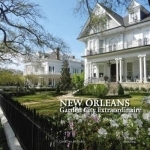New Orleans: Garden City Extraordinaire
BookThis item doesn’t have any media yet
2017 | History & Politics
Sometimes, the vocation of a place is hard to understand. New Orleans, like Venice, is built in a location that at first sight seems curious in the extreme. How could it be that these cities, built so precariously in the face of a watery threat, were to become among the greatest in the world? How could a site below sea level, in a swampy curve of the Mississippi River, become one of the most visited cities in the United States, and possess a unique kind of magic that separates it from other cities? It seems that the challenge posed by the location, the opportunities created and the resilience of the inhabitants were decisive. By a strangely circuitous route, places that seem to have little promise are transformed because they create an opportunity at a particular time. This guide, richly photographed, endeavours to highlight these plights. New Orleans has been described by Lawrence N Powell, in his study of New Orleans as "The Accidental City". Accidental it certainly is, and as a result it has assumed a supremely organic character. It really is about growth; growth against the odds.
The city has a unique spirit born of its constant battle for survival, frequently handicapped by nature's capacity to destroy in the form of hurricanes. It twists and turns radially with the river, extending itself in accordance with prevailing needs, with developments responding directly to the demands of the ordinary people (and eventually the wealthy) who live and work in this sub-tropical location. In spirit and character, New Orleans appears to rise, in the face of apparently overwhelming odds, to become an irreplaceable work of the human imagination. AUTHOR: Geoffrey Baker was born in 1931 and trained as an architect at Manchester University. He was a finalist in the Rome Scholarship in Architecture in 1957, 59 and 61. In 1964, on receiving an Italian Government Scholarship, he completed his Master's Degree in Rome focusing on the work of Alberti and Palladio. Following practice in Birmingham and London, he taught at the University of Newcastle-upon-Tyne, where he gained his doctorate in 1971 with an analytical study of Le Corbusier, later to be published as Le Corbusier: An Analysis of Form.
He has taught architectural design, history and theory for over 30 years and developed expertise in the analytical dissection of buildings and cities. SELLING POINTS: * This richly illustrated guide endeavours to highlight how New Orleans, a city built precariously close to a watery threat, became one of the greatest metropolises in the world * Acknowledges the challenges posed by the city's location, as well as the opportunities this location created and the resilience of the inhabitants who have made New Orleans their home, past and present 400 colour
Related Items:
| Published by | Images Publishing Group Pty Ltd |
| Edition | Unknown |
| ISBN | 9781864707175 |
| Language | N/A |
Images And Data Courtesy Of: Images Publishing Group Pty Ltd.
This content (including text, images, videos and other media) is published and used in accordance
with Fair Use.
